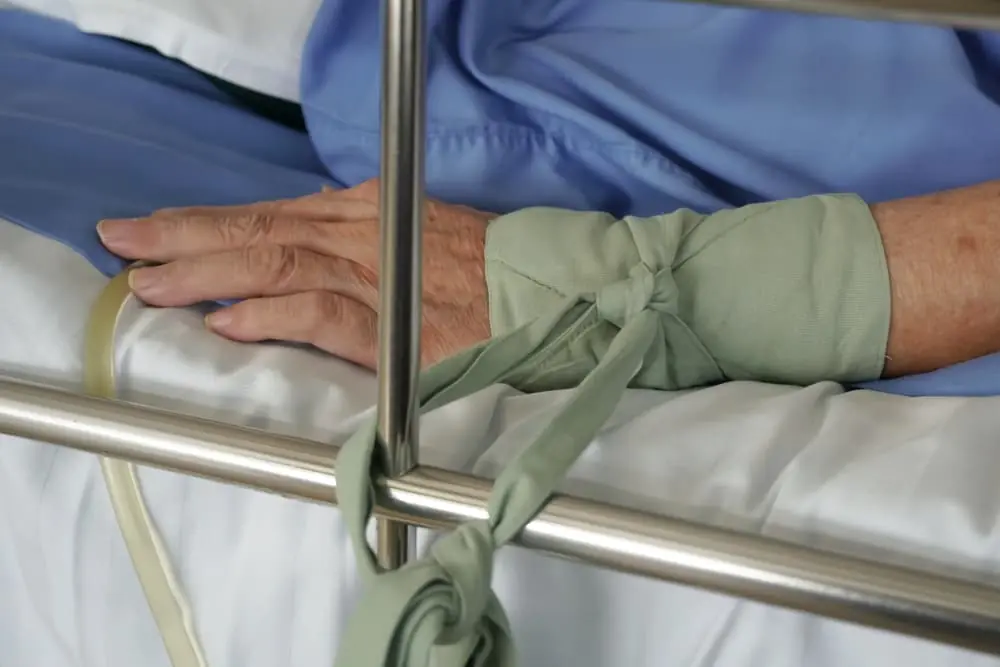How Bedsores Can Lead To Life-Threatening Infections in Nursing Homes
Nursing Home AbuseUnderstanding how bedsores can lead to life-threatening infections in nursing homes is necessary for families monitoring their loved one’s long-term care. These painful sores are a serious health risk for nursing home residents, especially those who have limited mobility or are immobile. Bedsores are often a result of nursing home neglect, which is a form of nursing home abuse and should be reported.
If your loved one suffered bedsores that led to life-threatening infections, you’ll want to consult a nursing home abuse lawyer immediately. Nursing home neglect is reprehensible and, unfortunately, common, with one in ten residents becoming a victim. Schedule your free consultation to have your story heard and legally assessed. You may be entitled to recover substantial compensation for your loved one’s injuries or wrongful death.
How Bedsores Can Lead to Life-Threatening Infections in Nursing Homes

Pressure ulcers, or bedsores, are areas of skin damage caused by a lack of blood flow. Bedsores usually begin as purple, blue, and red marks on an individual’s skin. When left untreated, the sore breaks the skin, becoming an open wound more susceptible to infections like sepsis and cellulitis. In extreme cases, bedsores can extend deeply into the skin, exposing bone, which dramatically increases the risk of life-threatening infections. The four stages of bedsores and symptoms to observe are as follows:
- Stage One Bedsores: Red, purple, or bluish discoloration on the skin appears like a bruise that doesn’t fade when pressed. The individual’s skin may feel warm to the touch. It may also itch or burn.
- Stage Two Bedsores: The skin breaks open, becoming an open sore resembling an abrasion or blister. The skin around the wound may appear pink or red, and the area is painful or tender.
- Stage Three Bedsores: The sore deepens and often begins to look like a crater. Dark patches of skin frequently appear around the edges of the bedsore.
- Stage Four Bedsores: The bedsores’ wounds become severe, exposing muscle, bone, or joints. There’s a high risk of severe bone infection known as osteomyelitis. At this stage, bedsores can also lead to a possibly life-threatening infection called sepsis.
Stages three and four wounds covered with black dead tissue (eschar) or creamy thick, slimy tissue that is yellow, white, gray, or black (slough) are unstageable full-thickness pressure injuries. Due to these thick coverings, the severity of the bedsore can be more challenging to detect. In addition to cellulitis, bone infections, and sepsis, sometimes complications with bedsores can lead to cancer, such as a Marjolin ulcer—the development of cutaneous squamous cell carcinoma in the site of the ulcer.
Negligent Causes of Bedsores in Nursing Homes
Any nursing home resident can develop a bedsore during their stay. However, residents with medical problems preventing them from repositioning themselves are at higher risk because they are dependent on a caregiver to reposition them. Nursing home residents who are at higher risk include bedridden residents, wheelchair-bound residents, and those with limited mobility issues. Common negligent causes of bedsores leading to life-threatening infections in nursing homes are as follows:
- Failure to Reposition Residents: Regularly changing a resident’s position helps to redistribute pressure on the skin, preventing blood flow restriction and the development of bedsores. Failure to reposition your loved one constitutes nursing home neglect.
- Inadequate Staffing: Chronic understaffing is a significant issue, with 87 percent of nursing homes experiencing moderate to high staffing shortages. Understaffing makes it impossible for care teams to provide adequate care, which explains how bedsores can lead to life-threatening infections in nursing homes.
- Inadequate Staff Training: Caregivers who are not adequately trained may not recognize the signs of bedsores or understand and implement prevention techniques.
- Poor Hygiene and Incontinence Care: Allowing residents to remain in soiled clothing or wet bedding increases the risk of skin breakdown and life-threatening infections. Unfortunately, these are standard examples of resident neglect.
- Lack of Proper Hydration and Nutrition: Dehydration and malnutrition weaken the skin, making it more susceptible to bedsores that can lead to life-threatening infections. Sudden weight loss may be a sign of malnutrition leading to bedsores.
- Failure to Provide Pressure-Relieving Devices: Not using gel cushions and positioners, tabletop pressure management pads, air-filled cushions, foam cushions, heel protectors, elbow protectors, or repositioning aids increases the risk of bedsores and constitutes negligence.
- Ignoring Early Signs of Bedsores: Delayed treatment of discoloration or other symptoms of minor bedsores allows them to worsen into serious wounds that can lead to life-threatening infections, including sepsis. This neglect is a common consequence of insufficient staff training.
- Lack of Medical Attention: Nursing homes without adequate medical staff or on-site medical treatment can cause bedsores to worsen. Failing to involve doctors or wound care specialists can result in preventable life-threatening complications.
- Overmedication or Sedation: Excessive and intentional overuse of sedatives can reduce a resident’s mobility, increasing their risk of developing bedsores. Overmedication is nursing home abuse and should also be reported.
- Failure to Develop and Follow a Care Plan: Failing to develop a nursing home care plan that assesses and addresses a resident’s risk factors is negligence. Without an adequate care plan in place, a resident can develop bedsores that can lead to life-threatening infections and wrongful death.
Other factors associated with bedsores include a resident’s age and health. Medical conditions that increase the likelihood of bedsores include dementia or Alzheimer’s disease, spinal cord injuries, muscle spasms, incontinence, and diseases that decrease blood flow. Neglect that allows bedsores develop and lead to life-threatening infections in nursing homes is despicable.
Families must establish that their loved one’s bedsores that led to a life-threatening infection were due to negligence to secure compensation. Elder neglect cases are complex and benefit from contacting an experienced nursing home abuse attorney. They prove negligence so that you don’t have to.
Questions to Ask Nursing Homes if Your Loved One Has a Bedsore

When you discover that your loved one has a pressure ulcer while residing in a nursing home, it can be alarming. Getting to the bottom of why they have the bedsore is imperative for understanding whether it was unavoidable or resulting from nursing home neglect. Questions to ask the nursing home director and care team to determine a need for further concern and investigation include:
- When did staff first notice the wound?
- How severe (stage 1, 2, 3, or 4) is the pressure ulcer?
- How was the treatment plan followed?
- How many hours was the resident left in bed or a wheelchair without being repositioned?
- How strictly was the care observed and the attention to treat the bedsore noted?
- What is the staff going to do to treat this bedsore moving forward?
- Should this bedsore have been prevented?
You should also ask to review the nursing home’s standard of practiced care for basic hygiene and report suspected violations to the appropriate authorities, such as local ombudsmen officers. A nursing home abuse attorney can ask these questions on your behalf and take over further investigations into the nursing home abuse when bedsores lead to life-threatening injuries or wrongful death.
How a Nursing Home Abuse Lawyer Can Help
A lawyer helps ensure justice and accountability by identifying all liable parties and holding them responsible for neglecting nursing home residents. First and foremost, they can help protect the victim by assisting families with relocations to safer long-term care facilities. Attorneys can guide you through reporting abuse to relevant state agencies or report the abuse on your behalf. They aim to minimize your responsibility so that you can prioritize your loved one’s health and well-being or mourn their untimely loss.
Free Consultations
Nursing home abuse lawyers provide free consultations to advise families looking for answers for their loved ones. During initial meetings, attorneys listen to understand while identifying the strengths and weaknesses of your claim. This is the time to ask all your questions and explore your legal right to recover compensation for your loved one’s or your family’s losses.
Contingency Fee Arrangements
Most nursing home abuse lawyers provide contingency fee arrangements to assure their clients there is no risk to retain their legal representation. These arrangements guarantee no out-of-pocket expenses and stipulate that clients pay nothing unless their attorneys secure a settlement for their claim. In other words, no win, no fee. While some attorneys operate under an hourly payment structure, affordable nursing home abuse lawyers work on a contingency basis. There is no need to hire an attorney who doesn’t offer the peace of mind of contingency arrangements.
Case Investigation
Building strong cases involves comprehensive case investigation to pinpoint negligence and cement liability. Nursing home abuse attorneys meticulously review healthcare records with medical experts for signs of neglect and abuse, such as a history of slip and fall accidents and untreated conditions. They also gather physical evidence, including any photographic or video evidence of neglect causing the bedsores that lead to life-threatening injuries in nursing homes. Interviewing witnesses, such as nursing home residents, staff, maintenance, and visitors, can produce invaluable testimony that strengthens your claim.
Claim Valuation of Compensatory Damages
Accurate claim valuation is pertinent to ensure that maximum calculations are made. Nursing home abuse attorneys guarantee that the maximum value is confirmed by assessing compensatory damages with relevant expert witnesses. These experts include healthcare professionals, economists, and life care planners. Damages attorneys and their network of experts determine when evaluating nursing home abuse claims are as follows:
- Healthcare Expenses: Your loved one’s medical costs are retrievable economic losses. These include emergency care, surgical intervention, aggressive infection control, wound care, monitoring, and preventative care. Pain management costs are also calculated.
- Cost of Future Care: The ongoing and future medical care costs due to the life-threatening infection caused by neglecting to treat a bedsore are assessed. Attorneys collaborate with treating physicians, healthcare experts, and economists to determine future medical care costs.
- Disfigurement or Disability: Complications from infections affecting bones, joints, and the bloodstream can cause long-term functional limitations, scarring, and disfigurement and have a negative psychological impact on victims. When bedsores lead to life-threatening infections and cause disfigurement or disability, victims may be compensated for those damages.
- Pain and Suffering: Your loved one’s physical pain and emotional suffering are intangible losses that may be compensated with viable documentation. These damages compensate victims for aches, chronic pain, sleep troubles, mental anguish, and the psychological impact of injuries. Families can help document these symptoms in a daily journal.
- Wrongful Death: When bedsores lead to wrongful death, families may be eligible to file for wrongful death benefits. These compensate for the claimant’s income losses and pain and suffering. These can include costs for the funeral and burial and income losses during periods of grieving. Wrongful death benefits also encompass compensation for a loss of financial support and inheritance and a loss of consortium or companionship.
Punitive damages are additional compensation applied in some cases when they go to court. They aren’t typical in nursing home abuse cases and are not calculated by attorneys. They are awarded by juries and reserved for heinous acts that warrant punishment for the defendant. Despite how heinous nursing home abuse is as a whole, families shouldn’t expect or depend on obtaining punitive damages in addition to their compensatory damages.
Negotiations of Fair Settlements
Due to complicated corporate policies, negotiating with nursing home insurance companies can be more challenging. These policies are carefully layered to protect company assets, making it harder to secure full compensation. You want a nursing home abuse attorney’s confidence, experience, and negotiation skills to represent you against these insurance claim adjusters. They will demand insurers pay reasonably or file a civil lawsuit to secure a settlement for your case.
Speak to an Experienced Nursing Home Abuse Lawyer

State jurisdictions determine how long victims and their families have to file a claim for nursing home neglect or abuse. Don’t delay seeking immediate legal counsel. You’ll want to protect your legal rights to pursue compensation for your loved one’s injuries and damages or wrongful death. Consult an experienced nursing home abuse lawyer so that you can feel confident that your family has done everything possible to ensure your loved one’s voice is heard and represented during this difficult time.

Nathan Hughey, an attorney and fourth-generation South Carolinian, founded Hughey Law Firm in 2007. Before that, he spent five years defending nursing homes and insurance companies. Leveraging his experience, he now advocates for those injured or wronged by such entities, securing over $290 million in verdicts and settlements.